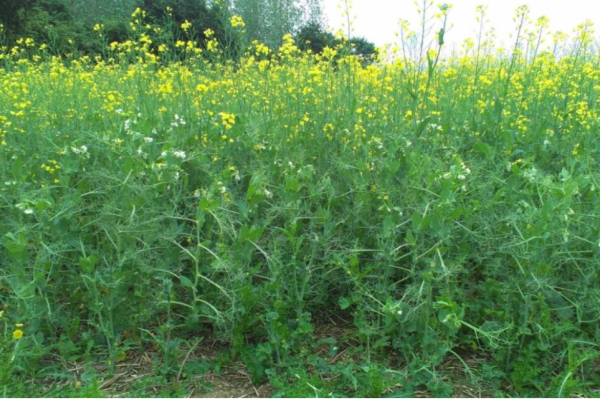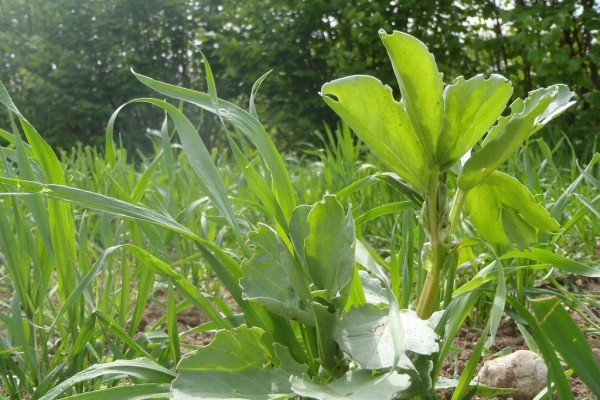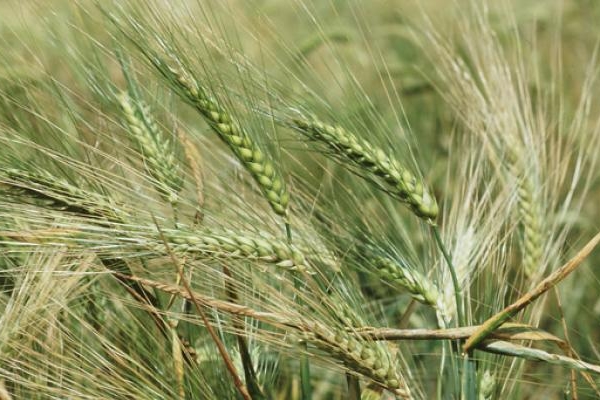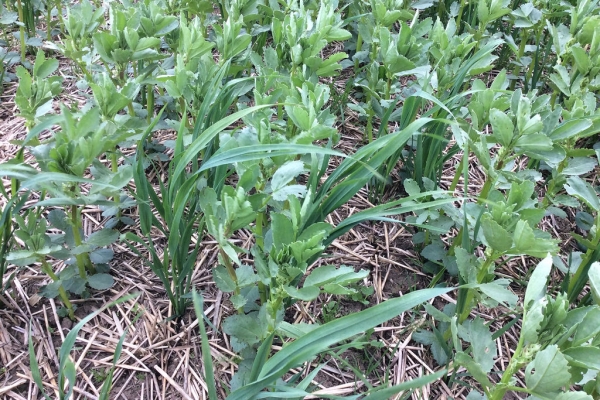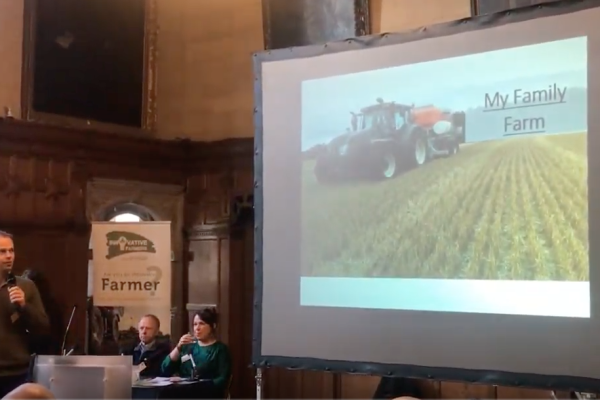Plant teams in the field – Intercropping in practice in the UK and Sweden
Intercropping has been shown to be beneficial for pest, disease and weed management, preventing lodging, improving water quality, soil fertility and biodiversity as well as increasing resilience to climatic and agronomic shocks. Much of the innovation is happening in farmer’s fields and on-farm trials are an important step towards enhancing understanding of the benefits and challenges of working with different plant teams in a variety of contexts.
The theory
Plants in monoculture have similar traits and compete for the same resources. Plants in species mixtures can have divergent and sometimes complimentary traits. Beneficial interactions between crop species include facilitation (e.g. suppression of weeds), resource sharing (e.g. mycorrhizal associations) and complementarity (e.g. differing crop architecture above and below ground reducing competition for resources.

Above: Facilitation, resource sharing and complementarity (Brooker et al, 2015)
Factors to consider
When deciding on a plant team combination it is important to consider the key objectives and the traits of the intercrop components to find a mixture that fits your needs. For example, which crop is the priority, what is the end-use? Is there a production challenge that you are aiming to address such as weed or pest pressure? Alongside this, it is important to determine the best seed rates and ratios, taking into account the competitiveness of the different crop species in the intercrop, and how varietal choice could be maximised e.g. to optimise maturation dates.
Intercropping in practice
In the UK researchers are working with a group of farmers and sharing experiences of different plant teams online and in the field as part of the DIVERSify project and the Innovative Farmers Field Lab ‘Intercropping in Arable Systems.’ The main mixtures can be grouped as cereal – legume mixtures and oilseeds plus companions. In 2017/18 four farmers trialled plant teams on their farms as part of DIVERSify; including carlin peas and spring triticale, wheat and beans on two different organic farms, and spring oil seed rape and beans. This year two of the farmers have been continuing trials. Here are some insights into some of the plant teams tested over the last couple of years and key findings from the trials…
James Hares, Winter Wheat and Beans at Roundhill Farm, Wiltshire
Motivations: Weed control (particularly wild oats) and increase protein of a mixed livestock feed
With a heavy wild oat problem, James hoped that intercropping beans with wheat would allow the wheat to dominate the wild oats and outcompete them in his organic system. In 2017, James established two 1 hectare (ha) strips – one an intercrop of beans (Tundra at 175kg/ha) and wheat (Mulika at 125kg/ha) and one of monoculture beans. Both were drilled with a Weaving Sabre Tine drill, the intercrop in two passes. James observed a huge difference in the size of the weeds in the monoculture vs the intercrop and analysis showed that there was an average of 74% less dry matter weed biomass in the intercrop that the monoculture! The vast majority of these weeds were wild oats.
Although the bean yields were low due to the weed pressure in both fields, there was a slightly higher bean yield in the monoculture (0.59 t/ha) than in the intercrop (0.48t/ha beans; 1.43t/ha wheat) suggesting that the wheat may be competing with the beans. Nevertheless, the combined yield of the intercrop was higher than the monocrop, and as the intercrop was harvested and used as a mixed feed for his own livestock, James felt that the lower bean yield was compensated for by the weed suppression benefits and additional feed value of the wheat.
Based on this success James decided to repeat the trials again in 2019 (with a much smaller area of monoculture). He lowered the wheat seed rate to 100kg/ha and increased the beans to 200kg/ha in both the intercrop and monoculture. The weed biomass results replicated the previous year, with 73% less dry weed biomass in intercrop v monocrop (again mainly wild oat although more black-grass, charlock and poppies than in the previous year). Unfortunately, the weed burden in the monoculture was so high that he had to mow the crop before the wild oats could go to seed and it was not taken to harvest.
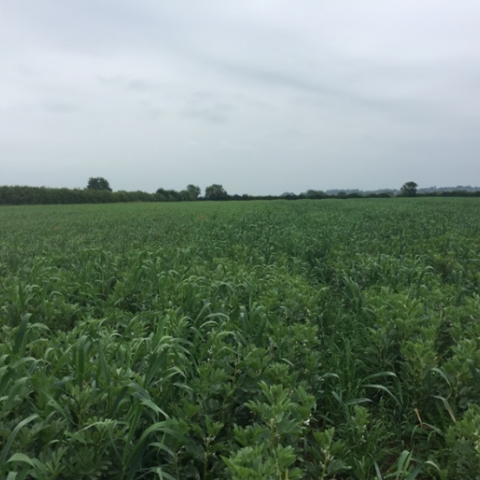

James noticed that the wild oats in the intercrop (left) had much less biomass than those in monoculture
Mark Lea, Carlin Peas and Triticale at Green Acres Farm, Shropshire
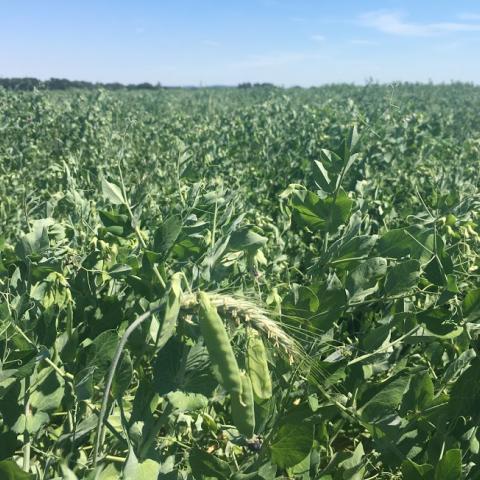
Motivations: Provide scaffolding for the pea crop and improve ease of harvest
Mark is growing carlin peas for Hodmedod’s ‘British grains and pulses’ however due to their high level of biomass they tend to lodge and can make harvest challenging. In 2017/18 he trialled pairing the carlin peas with different seed rates of triticale to determine which level provided optimal support for the crop. He obtained the highest yield of peas at the 20% seed rate (2.29 t/ha) but all of the intercropped strips had a higher pea yield than the monoculture peas (which yielded 1.91 t/ha). However, the highest triticale rate of 30% was Mark’s favourite when it came to harvest as the standing ability of the crop was much improved, as you can see in the images below, and it was much more pleasant to combine.
In 2018/19, Mark split his field to try an increased triticale rate of 40% in comparison to a 20% rate. He reports a very challenging year for organic pea production due to the high weed burden but that the intercropping did aid in weed competition as well as providing a good level of scaffolding as per the year before. However, he felt that the 40% triticale was providing more competition than he would like with the peas.
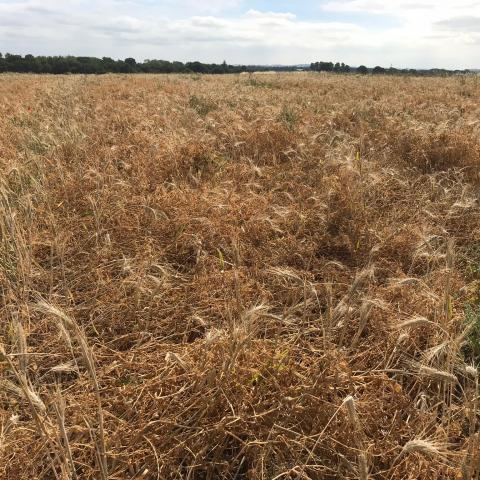
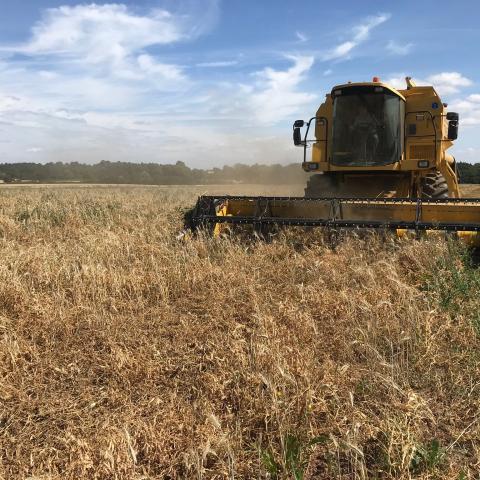
Comparison between 20% triticale (2.29 t/ha) and 30% triticale (2.04 t/ha) intercropped with carlin peas
Andy Howard, Linseed and Oats at Bockhanger Farms, Kent
Motivations: Oats to facilitate better linseed establishment via reduction of pest and disease pressure
Andy has been innovating with a number of plant teams over the last 3 years since completing his Nuffield Scholarship on ‘Intercropping and companion cropping in arable systems’ which is available on Agricology.
Having observed better linseed establishment in areas of the field with wild oats in 2018, Andy wondered if the oats act as a temporary nurse crop to help reduce flax flea beetle attack and aid linseed establishment. He therefore drilled a crop of linseed (700 seeds / m2) with a nurse crop of oats (at 0 / 70 and 140 seeds / m2). The oats were killed off with herbicide once the linseed was established.
Assessments in April 2018 showed an average of 13% higher linseed plant survival with oats at 70 seeds/m2 when compared to no oats, and 17% higher plant survival with 140 seeds /m2 oats. (285 plants /m2 with no oats 323.5/m2 with 70 seeds/m2 oats and 333.72 plants in 140 seeds / m2 oats).


Flax flea beetle caught in water trap; shot-holing of linseed
Pest damage scores (PDS) were assessed, based on percentage shot-holing by flax flea beetle. There was a trend of lower PDS on the linseed intercropped with oats (average PDS of 1.71 with oats at 70 seeds per m2 and 1.79 with 140 plants / m2 versus an average of 2 in linseed monoculture). This year Andy is also trying out 3 other plant teams; beans and oats (with the PGRO), oilseed rape (OSR)-peas-linseed (OSR has failed) and lentils and linseed.
Innovations in Sweden
Alongside DIVERSify and Innovative Farmers, another Horizon 2020 funded project, DiverIMPACTS, is facilitating a growing network to share experiences of crop diversification from across Europe. This includes many different case studies which include looking at diversifying rotations and intercropping and their integration across value chains. Hodmedod’s (UK) and Nordisk Ravara (Sweden) are businesses supporting farmers to diversify their rotations and produce locally grown pulses – including lentils, peas and beans. These crops can be challenging to produce but have clear benefits for the rotation. Challenges include suffering from lodging (and consequent impact on harvestability and quality) as well as weeds, pests and diseases. Many farmers are exploring the potential for intercrops to address some of these issues, and the businesses buying their products are keen to support them in finding solutions. In June, I and a group of farmers, Hodmedod’s staff, and researchers travelled to Sweden to visit farmers innovating with intercropping and to share experiences. Here is an insight into what we saw and learnt:
Per Modig, Lentils and Oats, Fagraslätt farm, Sweden
Motivations: Oats to provide scaffolding to lentils and aid weed suppression
Lentils have been traditionally grown in some parts of Sweden and are on the increase again. Lentils are low growing and lodge easily. In the gravel soils of Southern Sweden this can mean harvesting small stones which are difficult to clean out. They are also sensitive to weed competition, particularly if there is poor/delayed establishment. In response to this, many of the farmers we visited are intercropping with oats – to hold the lentils off the floor, whilst also supressing weeds.
Per Modig had teamed oats with red lentils and green puy lentils as he found them easier to separate than other cereals. He had drilled lentils (90kg/ha) with oats (40kg/ha) and compared weed biomass and crop yield to a monoculture strip. Although the oats could increase the moisture content of the lentils, Per felt this was outweighed by benefits for scaffolding and weed suppression. His expected harvest was around 1-1.5 t/ha of lentils and about the same for the oats. His on-farm separation set up, which also served other farmers in the Nordisk Ravara network, included a series of cleaners including a spiral separator which was particularly effective at separating similar sized seeds.


Red lentil and pea trials at Per Modig’s farm (left). Spiral separator forms part of Per’s seed cleaning and separation business (right)
Per Modig’s trials are part of a trial at the Swedish Agricultural University, Alnarp, comparing different varieties of the traditional puy lentil (Gotlands Lins – a traditional Green puy lentil grown widely in Gotland until 1945, and Amnesia a modern French variety) intercropped with oats, and the effect of any additional harrowing. They were drilled with lentils at 100% RD and oats 20% RD. Previous research carried out at SLU Alnarp had found an increase in protein in oats intercropped with lentils – this could either be due to translocation of nitrogen (N) from the dying lentil roots, or (and more likely) due to there being a greater availability of N with their being less intraspecific competition with other oats.
Raj Chongtham Iman, Peas and Oats, SLU Alnarp, Sweden
Motivations: To increase resilience to in field heterogeneity and climatic shocks
As part of another H2020 research project Remix we visited another trial which looked at the impact of intercropping oats and peas to help manage in-field heterogeneity and resilience to stresses – including drought and flooding, and nutrient availability.
Peas and oats were a common mixture grown by the group in Sweden. The UK farmers were a little concerned about how to separate a crop of peas and oats as split peas can be difficult to clean, but the Swedish farmers explained that they used screens with long slots for oats as well as a spiral separator and have not found it to be a problem.

Grey peas 190kg/ha and oats 150kg/ha drilled with system chameleon. Peas suffered from a dry spring and insects
In summary…
These examples are just a brief snapshot of a huge amount of innovation happening in the field, but demonstrate some of the potential benefits of intercropping for weed suppression, scaffolding and pest control. The effectiveness of different plant teams seems to vary significantly from farm to farm and from year to year, so the best way to learn what can work for you is to try on a small area of your own farm. In selecting your plant team, be clear about what your objectives are, what the intended use is, and which crop is your priority.
Katie Bliss is an agroecologist and researcher on the Innovative Farmers Field lab on Intercropping and the DiverIMPACTs project Case Study 15 and the Knowledge Exchange Manager for Agricology.
This blog is featured in Issue 7 of the Direct Driller; a farming magazine designed by farmers for farmers to educate and inform the industry about direct drilling and no-till techniques, soil regeneration and soil conservation in arable and mixed farming situations.



